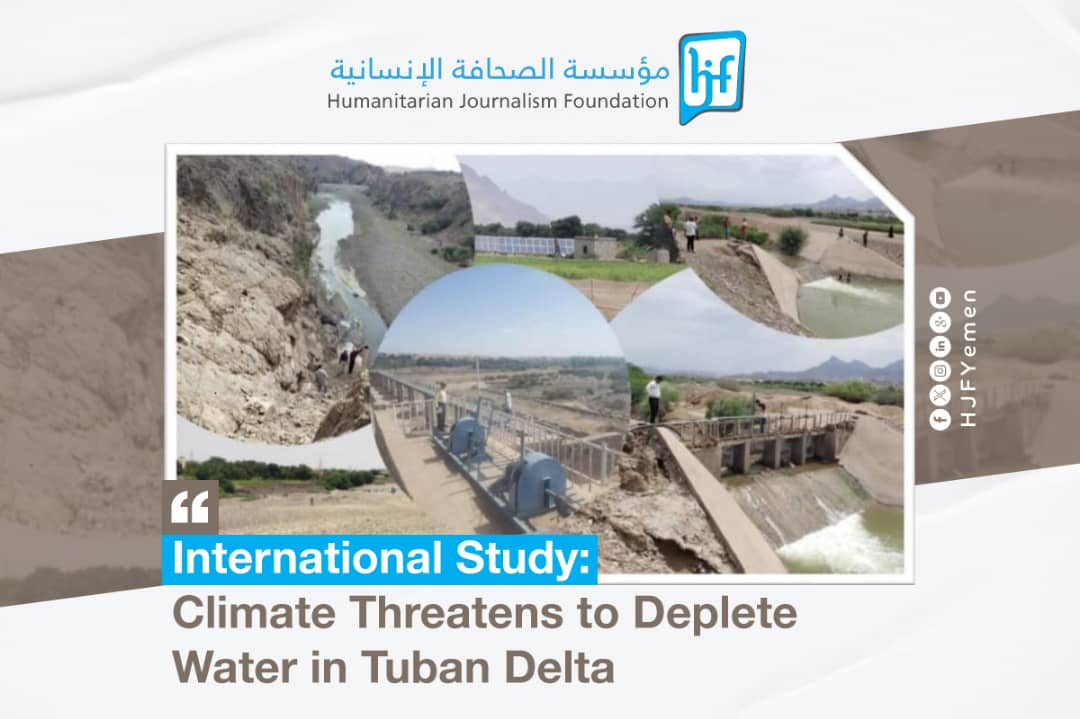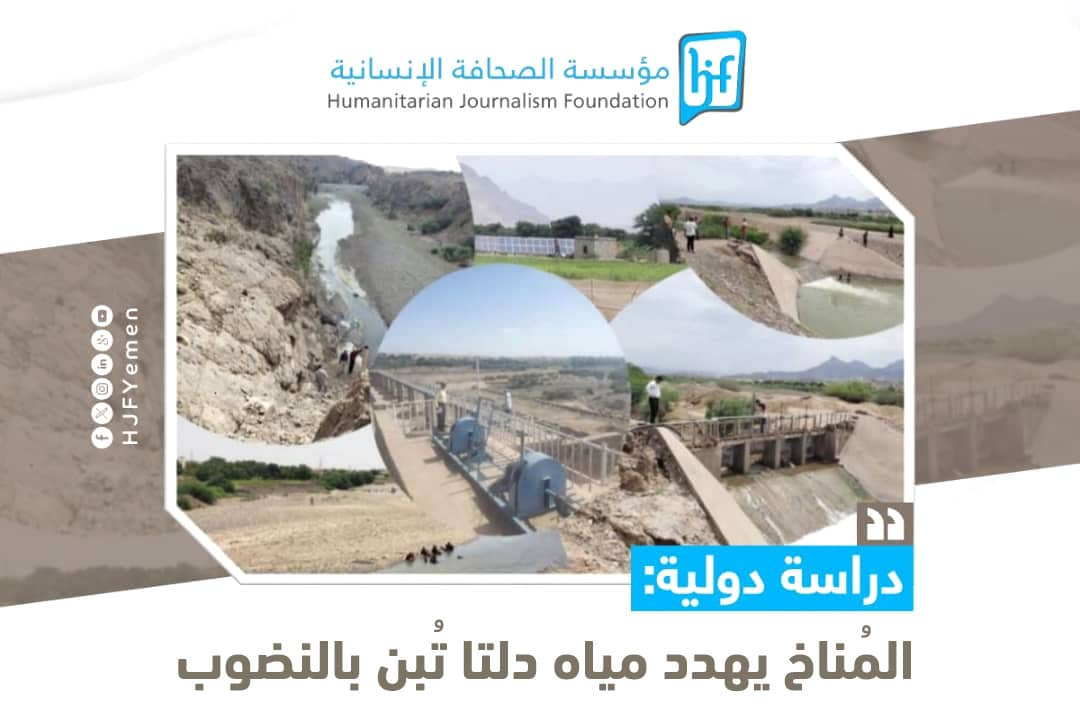Aden Faces High Climate Risks, Study Warns International Study: Climate Threatens to Deplete Water in Tuban Delta
2024-09-07
* Bassam Al-Qadhi – Humanitarian Journalism Foundation
An international study has revealed that groundwater in the basins of Tuban Delta, which primarily supply the city of Aden and parts of Lahj Governorate in southern Yemen, is facing depletion due to climate change and the increasing number of illegal wells and drilling activities.
This 2023 assessment reveals a grim picture: 3,600 wells have been identified, with 1,200 of them already dry. Furthermore, the groundwater level is dropping by an average of one meter annually due to an imbalance between recharge and discharge rates.
If the current imbalance persists, the study warns that most wells will either run dry or become unusable due to high salinity by 2060, leaving thousands facing a severe water crisis.
A UN study released in November 2023 underscored the urgency of the water crisis in Yemen, revealing a water deficit of 84 million cubic meters in the lower Tuban Delta region during 2022.
Numerous Challenges
A new study warns that the surface and groundwater resources of Tuban Delta are under severe strain, facing a triple threat of climate change, overexploitation, and a lack of sustainable water management.
The study underscores that the city of Aden is facing significant climate-related risks and urgently requires additional water resources. It recommends the immediate construction of a 50 million cubic meter desalination plant powered by solar energy, followed by the establishment of additional plants with a capacity of 10 million cubic meters every 5-10 years.
The study reveals that the lower region, encompassing all of Aden and parts of Lahj governorate, is the most vulnerable to climate change impacts. This area is exposed to four primary climate hazards: floods, droughts, sea-level rise, and saltwater intrusion. These threats pose a significant risk to water supply systems and coastal infrastructure.
Furthermore, the study highlights the need for innovative, sustainable solutions to address the growing water demand in the lower region and mitigate saltwater intrusion. It also exposes administrative shortcomings and underscores the necessity of a comprehensive, sustainable strategy for water management and distribution.
A Significant Water Deficit
According to the study, water supply estimations for 2022 include renewable water, flow from highlands, and non-conventional water resources, totaling 10,175,73 million cubic meters.
The study reveals a significant disparity in water usage, with agriculture consuming a staggering 244 million cubic meters, while domestic use accounts for 36 million cubic meters. This translates to a whopping 82% of total water consumption being dedicated to agriculture. This imbalance between available water resources and consumption has resulted in an overall water deficit exceeding 53 million cubic meters.
The study analyzed total annual water usage under two contrasting projections: a baseline scenario, assuming no improvements in water management, and an enhanced scenario, incorporating improved irrigation systems and a slower population growth rate. These projections highlight the potential consequences of different water management strategies."
The study concludes that there is an urgent need to address water management techniques and frameworks based on Integrated Water Resources Management (IWRM) principles. This is crucial for mitigating climate risks, regulating socio-economic activities, and ensuring environmental sustainability.
The study aimed to evaluate current and future water supply, water demand, and climate-related risks and impacts under various socio-economic and climate scenarios.
Lack of Planning and Management
The study revealed that all three regions face significant challenges stemming from a lack of comprehensive water and climate management plans, inactive agricultural plans, inadequate monitoring mechanisms, and inactive Water Users Associations (WUAs) in the agricultural sector. These shortcomings have driven farmers to dig illegal wells, leading to the depletion of groundwater resources and a decline in water quality (salinization).
The study leverages local data, remote sensing data, global climate models (GCMs), and the geographic information system software QGIS to evaluate water resources and climate risks under diverse scenarios.
The study revealed that the development of numerous dams and other rainwater harvesting technologies, coupled with the excessive use of surface water in the upper reaches of Tuban Delta (upstream), has resulted in a decline in surface water availability in the lower reaches of Tuban Delta (downstream). Consequently, limited water reaches the lower region, with no water reaching the ocean. This has forced residents and farmers to rely heavily on groundwater, utilizing renewable energy sources. As a result, a water deficit of 84 million cubic meters occurred in 2022.
Future Projections:
The MRI-ESM2-0 climate model and QGIS were used to analyze future water availability under two shared socioeconomic pathways (SSP3: RCP 7) and (SSP5: RCP 8.5).
Two scenarios were evaluated to assess future water supply. The first scenario assumes no new development, relying solely on existing infrastructure. The second scenario explores the potential benefits of wastewater reuse and the construction of a desalination plant in Aden every 20 years, with a capacity of 10 million cubic meters.
The study's projections for water availability in the three regions up to 2100 show a significant difference depending on the scenario. Without any improvements to water management, water supply is projected to be around 235 million cubic meters under the SSP5 scenario and 254 million cubic meters under SSP3. However, implementing the improved scenario, which includes measures like wastewater reuse and desalination, could significantly boost water supply to 424 million cubic meters under SSP5 and 358 million cubic meters under SSP3.
The study's findings indicate that water use will reach 696 million cubic meters and 369 million cubic meters in 2100 under the baseline and improved demand scenarios, respectively. Water balance estimates show that under the baseline scenarios, a water deficit exceeding 400 million cubic meters is projected in 2100 under both climate pathways (SSP3 and SSP5). The lower region is expected to experience the most severe water scarcity due to increased demand driven by traditional irrigation practices and population growth.
A new study reveals that the Lower Region will not be able to recover its water deficit, with all scenarios predicting a severe water shortage ranging from 60 to 80 million cubic meters even in optimistic forecasts. To address this critical issue, the LR region urgently requires additional water resources, including a 50 million cubic meter desalination plant powered by solar energy. The study recommends the construction of this plant as soon as possible, followed by additional plants with a capacity of 10 million cubic meters every 5 to 10 years.
Therefore, effective water allocation plans and additional water resources are crucial to meet the growing demand.
The study warns that all three regions could face a future marked by both drought and flooding. For instance, under SSP3 and SSP5 scenarios, extremely high rainfall rates could lead to flooding between 2060-2063 and 2074-2076, respectively. Conversely, droughts are projected to occur between 2029-2034 and 2069-2072.
Measures to Adapt to Climate Change
The study outlined several measures to adapt to climate change, including rehabilitation of irrigation canals and improvement of the existing irrigation system, rehabilitation of some wastewater treatment plants for reuse in agriculture, groundwater recharge, and establishment of a solar-powered desalination plant to meet the growing water demand in Aden. These measures aim to mitigate the impacts of climate change and ensure water security in the face of increasing drought and flooding risks.
The adaptation measures also include a disaster management plan with an early warning system in the upper part of Tuban delta (Dukum). This system is designed to mitigate flood risks and alert residents when water flow exceeds 150 m3/second. Additionally, a suitable disaster management plan is in place to minimize the impact of potential floods.
The study contains important findings and data that can be utilized by a diverse range of stakeholders, including Yemen's Environmental Protection Agency, Geographic Information System (GIS) units, Ministry of Water and Environment, Ministry of Agriculture, Irrigation, and Fisheries, Ministry of Education, Local Water and Sanitation Authority, General Authority for Water Resources, international partners, research centers, universities, water user associations, farmers, and local communities in both Aden and Lahj governorates.
To address climate change and water scarcity challenges in Tuban delta, the study recommends the Lower Region to secure additional water resources through a solar-powered desalination plant.
As recommended by the study, the rehabilitation of wastewater treatment plants, monitoring, and setting a suitable plan for reusing treated water for irrigation or groundwater recharge, along with the maintenance of irrigation canals and the application of modern irrigation methods, are crucial.
The study highlighted the importance of proactive measures to mitigate the effects of natural disasters. It urged the development of a comprehensive disaster management plan, including an early warning system, to effectively address flood and drought risks. Additionally, it emphasized the critical need for continuous monitoring of groundwater discharge to prevent overexploitation and the intrusion of saltwater into the lower region.
The same study recommends the implementation of ongoing capacity-building programs focusing on hydrological modeling, water use efficiency, water allocation, and climate change adaptation. It emphasizes that these measures can be strengthened by developing an integrated water resources management plan/strategy specifically tailored for Tuban Delta.
A New Water Management
The study stressed the necessity of developing a new water management plan that considers water governance, allocation, roles, and responsibilities. It also emphasizes the need for monitoring (training and equipment) to protect natural resources, particularly groundwater, and to address climate-related risks such as floods, droughts, and sea level rise.
The study further emphasized the crucial role of information management, including data collection and sharing. It highlighted the need for basin planning and management, as well as community-based organizations to facilitate decentralized water management. Additionally, it stressed the importance of addressing climate risks and implementing adaptation and mitigation measures. Protecting groundwater through monitoring and enforcement, ensuring water availability in agriculture, and implementing modern irrigation systems alongside exploring potential crop pattern changes were also emphasized.
Regarding decentralized management, the study pointed to the need for establishing and strengthening Water Users Associations (WUAs) to act as responsible bodies for sustainable water management among basin users. It emphasized the importance of considering water scarcity, water use efficiency, saltwater intrusion issues, and raising public awareness. The study also highlighted the need to foster collaboration and participation of stakeholders, including policymakers and research institutions, to manage water supply and demand in an integrated and sustainable manner.
About the Study
The study was conducted from June 2022 to late 2023 for the United Nations Human Settlements Programme (UN-Habitat). It was prepared by Dr. Khaldoun Mourad, the lead researcher and international expert in water resources, with contributions from Joris Olley, Walid Yaacoub, Julie Greenwald, Mohamed Zein, Abdelwahid Erman, Abdelraqib Al-Akishi, and Alaa Ali.
The study was reviewed by Professor Ronnie Berndtsson, Professor in the Department of Water Resources Engineering and Deputy Director of the Centre for Advanced Middle Eastern Studies, Lund University, Sweden. He was assisted by a team from government agencies in Aden, including the General Authority for Environmental Protection, the Ministry of Agriculture, Irrigation and Fisheries, the Ministry of Water and Environment, and the National Water Resources Authority.
The study is part of the Green Climate Fund (GCF) Readiness Project "Strengthening capacities of sub-national authorities and key actors in the water sector to adapt to climate change in the Tebn Delta," implemented by the United Nations Human Settlements Programme (UN-Habitat) in coordination with the Yemeni Environmental Protection Authority, and various national and international stakeholders.
*A science journalist specializing in covering climate, environmental, and health issues.
- This report was produced with the support and supervision of the Humanitaria Journalism Foundation (hjf) as part of the #Yemen_Climate_Risk campaign.




